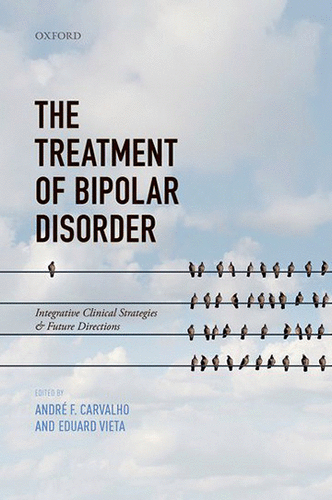The Treatment of Bipolar Disorder: Integrative Clinical Strategies and Future Directions

This is a no-nonsense book, “just the facts, ma’am,” as attributed to Joe Friday, the Dragnet detective. The 31 chapters cover all aspects of the treatment of bipolar disorder, including early prevention, treatment of children, maintenance therapy, treatment of the elderly, and the always problematic prevention of recurrent depression. Each chapter has a sparse introduction and then launches into a synopsis of nearly every major clinical trial, sparing no detail of subject number, comparison group, method, and results in appropriate statistical detail.
The organization of the book is quite useful. The chapters are small, rarely more than 15 pages, focused on one theme only. One can go directly there to read about that theme without wading through other material. The chapter on adolescents and children by Dr. Philip Hazell, for example, moved directly to high-risk research and the problems raised by considering early signs of mania versus early depression. Similarly, Drs. Dina Popovic and Vieta’s maintenance chapter sticks to its unique role and does not stray into acute treatment and its problems. The clarity and breadth of the presentation and the uniform excellence of each chapter are remarkable for a book with 37 authors from Europe, Australia, and both Americas. Dr. Vieta’s experience as senior author of the International Society for Bipolar Disorders’ task force report on antidepressant use in bipolar disorders (1) seems to have served him well. Many of its authors are also represented here.
It was the wisdom, however, rather than the facts that I found most satisfying as a reader. In almost every chapter, the last two to three pages, after all the facts are in, offer a well-balanced, straightforward summary of what is known, what it means, and then what the clinician can do with the information. As a clinical reference and as an advanced teaching tool, the book is second only to an exhaustive reading of all the studies ever written. The wisdom reflects Drs. Carvalho and Vieta’s care to pick authors from many countries to offer a focused but clearly senior expertise into the many facets of bipolar disorder.
I learned the difference in clinical approach for the maintenance treatment of a patient who has just experienced a depressive episode, compared with the approach for a patient who has had an index manic episode, in the chapter by Drs. Dina Popovic and Vieta. For rapid cycling, the chapter by Drs. Konstantinos N. Fountoulakis and Dimos Dimellis skillfully and fully dissects the effects of the wide range of psychopharmaceuticals often deployed for this troublesome syndrome and in the end, advocates lithium, with an appropriate nod to the well-studied antipsychotics. I found the chapter on cyclothymia by Drs. Giulio Perugi, Giulia Vannucchi, and Lorenzo Mazzarini particularly sensitive, in the clinical approach to an understudied syndrome that they approach as an opportunity for prevention. The use of pharmacology here is sparing, and instead emphasis is placed on psychoeducation and targeted psychotherapy to help the patient modulate his or her own hyper-responsiveness. Psychotherapy is discussed well in several chapters.
Given the book’s heft with more than 500 pages, I did not expect to finish it at any particular time, but as I began reading I was drawn in to reading it all, by the opportunity to learn experts’ approach to treatment in their special area of the common, but nonetheless complicated, illness bipolar disorder.
1 : The International Society for Bipolar Disorders (ISBD) task force report on antidepressant use in bipolar disorders. Am J Psychiatry 2013; 170:1249–1262Link, Google Scholar



